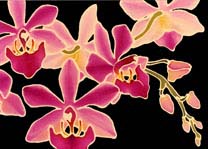I prefer to grow my Variegata Oncidiums (Tolumneas) in small (two-inch) clay pots in a medium comprised of small dolomite gravel and charcoal. This allows them to be watered almost daily, yet they dry out by nightfall. I hang them from wire suspended up in the rafters of my warm (60 degree) greenhouse, where it is bright, warm, and there is a lot of air movement from the turbulating fans intended to redistribute the warm air that collects near the roof.
The best information I have seen on the culture of Variegata Oncidiums can be found in the book, "Breeding Variegata Oncidiums" by William Whitman Goodale Moir and May Moir, published by the Harold Lyon Arboretum. The chapter entitled Care is reprinted below.
Care
Stoloniferous plants are better placed on wood, fern slabs, live host plants, or even attached to posts or a concrete wall rather than in pots, because they outgrow the pots and climb all over everything within reach. The other type of Variegata, which do not have long stolons, are best grown in small pots. Aeration of roots, even more than good light, is the most important single factor in raising these epiphytic plants. Those hybrids that are diluted with compact species are to be treated as compact growers, for their stolons are very short, even though their aerial roots are numerous, an inherited characteristic from their stoloniferous parents.
They should not be overpotted. If your plant is big, get shallow pots and loose potting media. Use a great deal of crock or charcoal in the bottom of deeper pots if you do not have shallow ones. When repotting, do not try to place aerial roots in the new compost or you will lose them. In most repotting, old roots are lost anyway, so do not try to save too many of them; but do not cut all of them either.
In attaching plants to trees, posts, or twigs, use soft string and a bit of fiber to get them established and hold moisture for a while. Coconut cloth, the fiber that grows around the base of coconut leaves, is a marvelous material to use. Cut the cloth in small strips and place them around the root area of the plants. This gives good drainage but retains enough moisture to get the oncidium started. Raphis palm stems (old ones) cut into lengths and fastened into pots are excellent material for the stoloniferous plants to grow on, starting the plant in the pot and then letting it climb up the palm stalk. These will last for years. If you use fern slabs, be sure they are thin enough to dry out between waterings. Woody vines are excellent hosts for these plants. Potted dwarf trees such as malpigia, eugenia, and citrus are also good hosts and save repotting orchids. But remember these are mostly for the stoloniferous plants. Compact plants grow twice as fast in clay pots that let air in and dry out. Do not use larger than three-inch pots and avoid plastic pots, as they do not dry out fast enough.
Do not divide your plants too much. If you lose the roots owing to fungus, clean them off, using a fungicide, and place each plant in a small, empty pot (with its tag), and put them in a cool, airy, shady place. Water daily or twice daily, depending on how dry your area may be. In due time, new roots should appear, and soon a new growth should start. When they are well established but not attached to the pot, drop in a little fern fiber or charcoal to reestablish them. Do not pot them up without roots or you will surely lose them. The empty pot treatment is excellent, even for brand new seedlings, to give them a good start. The only problem is when the roots become attached to the pot and you have to scrape them off to replant them. A little porous gravel in pots will help new seedlings grow better.
It is hard to advise on watering because of the many different environments in which the various plants are grown. Though these plants do not need too much water, they need it regularly, yet interspersed sufficiently to allow them to almost dry out between waterings. Misting lightly in very dry weather between waterings is often recommended. Remember these species receive daily dew in the long (six months) dry period they go through in their native homes. In most places in the Caribbean, this is from November to May. Remember also that those coming from higher elevations usually had more moisture.
Fertilizing is a tricky problem. It can be really helpful in open media but poison if the media are soggy. We usually start them out with one or two pinches of bone meal in the potting, depending on the size of the plant and the amount of good roots. Since fern fiber is acid (like the bark of trees), bone meal can neutralize it. Some species that are ground growers (scandens, bahamense, and sylvestre) love ground coral rock, since in their natural state they fasten their roots to coral underneath the grass in which they grow. Do not use long lasting pellets on these plants or you will surely kill them. Foliar fertilizers are beneficial if not overdone.
Mealy bugs, aphids, and whitewash scale are the commonest pests. In the absence of DDT, nicotine sulfate and soap will control them. Plants from some native habitats will have a bad rust on them, though they are usually intercepted by the plant inspectors. Plants like quadrilobium and lucayanum which have normally raised lines and dots on their leaves are not diseased, and should therefore pass inspection.
Air circulation is the most important factor in growing these plants.Therefore, grow them where the breezes can dry them out between waterings. Some store water in their aerial roots, and you can easily see from their thickness or thinness whether they have enough water. Also, the larger the plant, the more light it needs.
Always check the condition of your potting media; a plant may often hide the fact that a poor medium exists until it is too late.
Those species and their hybrids that come from higher elevations can grow in cooler areas. But, in general, they love warmth and light and can stand straight sun if their roots are in the shade and have excellent air circulation.
There are, among the species and their hybrids big growers and small growers. You should therefore try to segregate them so the big grower does not overshade the small ones. Also, remember that Variegata do not grow like other orchids and cannot be scattered among other plants but should be segregated. If they are in a crowded greenhouse, place them up higher and not too bunched together. However, if you have a dry house, crowding helps them conserve moisture. In general, it is helpful to read up on the environments they live in in nature, and then try to duplicate them.
Volcanic cinders and charcoal chips (either together or separately), as well as small bits of crock, make excellent media.
[Reprinted for educational purposes only from “Breeding Variegata Oncidiums”, (pps. 41-43), by W. W. Goodale Moir and May A. Moir, copyright 1980, by Harold Lyon Arboretum. Incidentally, this is a fantastic book, and if you have any interest in the Variegata oncidiums, I highly recommend that you attempt to obtain a copy.]

